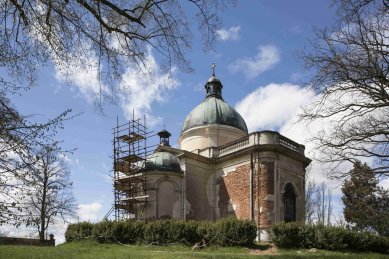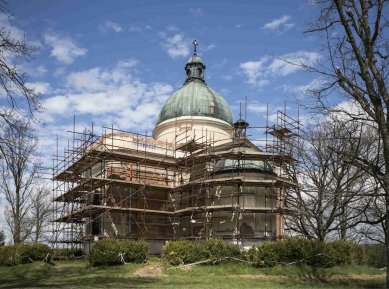
In Jemnice, the Pallavicini tomb is being restored
Source
Národní památkový ústav, územní odbor- né pracoviště v Telči
Národní památkový ústav, územní odbor- né pracoviště v Telči
Publisher
Tisková zpráva
11.05.2022 21:40
Tisková zpráva
11.05.2022 21:40
Czech Republic
Jemnice
The unique Neoclassical family mausoleum of the Pallavicini family in Jemnice is a remarkable work of architectural art. In recent years, the building has been in a state of disrepair and has appeared on the List of Endangered Cultural Heritage Sites. It seems that brighter days are now on the horizon.
The monumental tomb of the Italian noble family Pallavicini was built between 1900 and 1902 according to the design of the Viennese architect and court building advisor Otto Hofer in a historicizing Neoclassical style with a Greek cross floor plan and a dome above the crossing. The mausoleum is surrounded by an originally fenced and park-like area with a regular square floor plan, featuring the tomb in the center. A total of eight family members have been buried in the mausoleum, six of whom died in the 20th century. The construction and decoration of the chapel also involved Viennese creators and several other notable names, including the sculptor Ignác Weirich, who later worked in the Vatican.
"From a typological and stylistic point of view, this is a completely unique building in the broader region and a remarkable work of architectural art. Alongside the classicist tomb of the Haugwitz family in Náměšť nad Oslavou, the tomb of the Belcredi family in Jimramov, and the tomb of the Lobkowicz family in Netín, the tomb of the Pallavicini family in Jemnice can be considered one of the peaks of sepulchral architecture in the Vysočina Region," states Petr Severa from the regional specialist workplace of the National Heritage Institute in Telč.
More than seventy years of the building's history without continuous maintenance, following the confiscation of the Pallavicini property by the Czechoslovak state, combined with repeated acts of vandalism and the theft of individual decorative elements and the repeated theft of copper roofing, led to the mausoleum's state of emergency. The current stage of the mausoleum's restoration has been underway since 2020, involving construction and restoration activities, which were preceded by several years of preparation.
"The goal of the initial stage of the work is to stabilize the outer shell, especially to repair the functionality of the roofing of individual parts of the building, consolidate the stone decorative elements made of limestone, and also the plaster, particularly this year in the space below the crown cornice, thereby preventing further degradation of the exterior and interior elements of this monument," adds Severa.
The owner, the town of Jemnice, is successfully co-financing the restoration with funds from public sources: It is drawing subsidies from the programs of the Ministry of Culture of the Czech Republic, and the Vysočina Region Office is also contributing financial resources for the restoration.
All works, especially professional tasks, were preceded by a detailed, partially restoration-focused survey of conditions, which in some cases involved stratigraphic probes, the collection and laboratory analysis of samples of original surface treatments, as well as the identification of damage causes. Initial work focused on rescue measures to mitigate ongoing damage to the building, primarily caused by weather influences. At the same time, preparations were underway for the re-plastering of the mausoleum's façade surfaces. In the current stage, during the year 2022, further restoration of the stone elements of the building's shell will take place, along with the replenishment and reconstruction (recreation) of plaster layers and the restoration of two windows of the side aisles, including the restoration of their decorative grilles. Simultaneously, an evaluation of the effectiveness of individual interventions is being carried out to allow for their optimization and maximum efficiency.
The overall restoration is planned for the next several years, depending on the financial capabilities of the owner, with the restoration of the façade and roof being followed by the restoration of the interior. This will include the restoration of architectural elements and plasters, as well as the restoration of furnishings, encompassing artistic and craftsmanship works. The completion of the overall restoration in the future is planned to include the rehabilitation of the surrounding environment, including the currently significantly damaged fencing, which originally consisted of walls and columns with stone capitals, connected by decorative grilles. The town of Jemnice is preparing project documentation for the overall restoration of the tomb's surroundings, which will likely also include a caretaker's lodge, originally in the plan and now preserved only in outline.
The monumental tomb of the Italian noble family Pallavicini was built between 1900 and 1902 according to the design of the Viennese architect and court building advisor Otto Hofer in a historicizing Neoclassical style with a Greek cross floor plan and a dome above the crossing. The mausoleum is surrounded by an originally fenced and park-like area with a regular square floor plan, featuring the tomb in the center. A total of eight family members have been buried in the mausoleum, six of whom died in the 20th century. The construction and decoration of the chapel also involved Viennese creators and several other notable names, including the sculptor Ignác Weirich, who later worked in the Vatican.
"From a typological and stylistic point of view, this is a completely unique building in the broader region and a remarkable work of architectural art. Alongside the classicist tomb of the Haugwitz family in Náměšť nad Oslavou, the tomb of the Belcredi family in Jimramov, and the tomb of the Lobkowicz family in Netín, the tomb of the Pallavicini family in Jemnice can be considered one of the peaks of sepulchral architecture in the Vysočina Region," states Petr Severa from the regional specialist workplace of the National Heritage Institute in Telč.
More than seventy years of the building's history without continuous maintenance, following the confiscation of the Pallavicini property by the Czechoslovak state, combined with repeated acts of vandalism and the theft of individual decorative elements and the repeated theft of copper roofing, led to the mausoleum's state of emergency. The current stage of the mausoleum's restoration has been underway since 2020, involving construction and restoration activities, which were preceded by several years of preparation.
"The goal of the initial stage of the work is to stabilize the outer shell, especially to repair the functionality of the roofing of individual parts of the building, consolidate the stone decorative elements made of limestone, and also the plaster, particularly this year in the space below the crown cornice, thereby preventing further degradation of the exterior and interior elements of this monument," adds Severa.
The owner, the town of Jemnice, is successfully co-financing the restoration with funds from public sources: It is drawing subsidies from the programs of the Ministry of Culture of the Czech Republic, and the Vysočina Region Office is also contributing financial resources for the restoration.
All works, especially professional tasks, were preceded by a detailed, partially restoration-focused survey of conditions, which in some cases involved stratigraphic probes, the collection and laboratory analysis of samples of original surface treatments, as well as the identification of damage causes. Initial work focused on rescue measures to mitigate ongoing damage to the building, primarily caused by weather influences. At the same time, preparations were underway for the re-plastering of the mausoleum's façade surfaces. In the current stage, during the year 2022, further restoration of the stone elements of the building's shell will take place, along with the replenishment and reconstruction (recreation) of plaster layers and the restoration of two windows of the side aisles, including the restoration of their decorative grilles. Simultaneously, an evaluation of the effectiveness of individual interventions is being carried out to allow for their optimization and maximum efficiency.
The overall restoration is planned for the next several years, depending on the financial capabilities of the owner, with the restoration of the façade and roof being followed by the restoration of the interior. This will include the restoration of architectural elements and plasters, as well as the restoration of furnishings, encompassing artistic and craftsmanship works. The completion of the overall restoration in the future is planned to include the rehabilitation of the surrounding environment, including the currently significantly damaged fencing, which originally consisted of walls and columns with stone capitals, connected by decorative grilles. The town of Jemnice is preparing project documentation for the overall restoration of the tomb's surroundings, which will likely also include a caretaker's lodge, originally in the plan and now preserved only in outline.
The English translation is powered by AI tool. Switch to Czech to view the original text source.



0 comments
add comment











